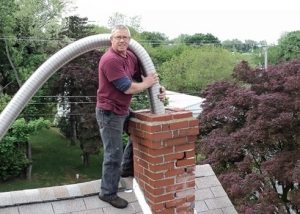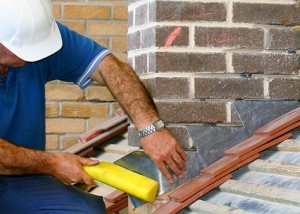The cap on the chimney pipe is used to protect the inside of the heating system from wind blowing, atmospheric precipitation, etc. It is important to choose the tip of the correct design and shape. The modern chimney cap (head) is available in a wide variety of colors, shapes, design and visual solutions.
Content
Types of chimney pipe heads
The installation of the hood on the chimney pipe gives these advantages:
- the chimney is protected from moisture in it;
- low cost of the deflector;
- prevention of possible pressure drops and its normalization inside the pipe;
- protection against the destruction of the chimney.
The deflector is produced in various shapes, which affects its characteristics and method of application. The main types are:
- ordinary umbrella (head);
- cap with weather vane;
- deflector;
- hood with hip roof.
The usual chimney head has the form of a cone or a four-sloped roof. It is considered the best option, and its cost depends on the specific dimensions. The head with the weather vane differs from the usual one only in the presence of decorative elements.
Note! Caps (heads, umbrellas), as well as other designs can slightly reduce traction, as well as lead to the appearance of reverse traction.
The deflector is designed to disperse the flows and prevent them from entering the pipe. If you combine it with a cap, then the performance will be reduced. The hood with a hip roof is used to protect against rain (rain). It is characterized by higher strength.
How to choose a cap on the chimney pipe
The functions of the hoods are to increase traction, prevent the destruction of masonry from brick, increase the efficiency of the chimney (up to 20%). Therefore, the choice of the tip must be taken very seriously.
At the initial stage, it is necessary to determine the design features of the tip. For the chimney, an ordinary hood will be enough, which will effectively protect from moisture and rain, and also prevent blowing into the stove.
For more sophisticated chimney systems, it is necessary to select a hood with a cone to carry smoke and with a built-in deflector. The differences of the heads depending on the type of chimney are in the technology of mounting the protective cap and the features of the fastening elements.
The choice of material for the manufacture of heads is also important. Copper structures are more expensive than steel, but they are more reliable and durable. The characteristics of zinc-titanium samples are close to copper and are characterized by high strength. Steel products have a life of 10-15 years.

For complex chimney systems, you may need a head with additional elements - a spark arrester or deflector
Some models have a special protective net that prevents debris from entering the pipe, but it slightly reduces traction.
Design features of caps
Chimney caps consist of 4 parts:
- skirts or adjoining to a roof;
- frame or brickwork;
- decorative chimney framing;
- Directly hood for chimney pipes.
The head is usually framed below by a sheet of stainless steel - a reflector that removes heat from it.
Note! The chimney hood should cover its upper horizontal surfaces. If there is an extension on it, then it should be closed.
Structurally, caps are divided into the following types:
- with a sloping roof;
- with a weather vane;
- flat top
- with a lid that opens;
- with ventilation clearance;
- with spark arrester.
Chimney tips with multi-pitched roofs provide the most efficient ventilation, and in the winter they prevent the accumulation of snow. Cover designs are much easier to maintain. Due to the presence of a ventilation hole, the free exit of combustion products is ensured. The head of the chimney pipes having spark arresters is provided for appliances that work on wood or peat in buildings with a roof made of combustible materials.

The cap with the weather vane will not only protect the chimney, but also a stylish decoration for the building
The cap on the chimney should be easy to put on, so to determine its size it is necessary to increase the largest linear parameters of the pipe by 4-5 mm. The emphasis on extensions can be at an angle of 90 degrees or inclined.
Material classification
The durability depends on the material used in the manufacture of the cap. The heads are made of copper, steel and zinc-titanium.
The most popular are copper designs. Since copper is a chemically active metal, over time, the destruction of parts occurs due to its entry into reaction with other elements. Ensuring a long operational period (more than 50 years) depends on the fulfillment of all installation requirements. The fastening elements of such heads are also made of copper.
It is not recommended to use caps made of painted steel in buildings with wood heating. They quickly become covered with soot and under the influence of high temperatures change color.
You can also find the heads of polyester and galvanized sheet. Such options are more economical, they are able to maintain their protective parameters (up to 10 years) in conditions of high humidity and temperature difference.
Mounting the deflector on the chimney pipe
A properly installed deflector allows the chimney to work efficiently and correctly. The principle of its operation is based on the use of wind flows as an additional tool to enhance or even the level of traction. Common chimney deflector configurations are:
- TsAGI deflector;
- round deflector;
- reflector design Grigorovich;
- H-shaped and open deflector.
Structurally, such an element of the chimney consists of a lower cylinder, a diffuser and an umbrella. It is made of galvanized steel, which is not susceptible to corrosion. The wind flow collides with the deflector and bends around it, which allows air to penetrate into the upper part of the product and increase traction. In addition, there is an extension of the stagnant smoke in the system.
Note! Intensive air movement in the deflector increases traction several times.
Air enters chimney and ventilation systems through special gaps located in the upper cylinder. The downstream wind can make it difficult to remove smoke and reduce draft in the pipe. To deal with such flows, the deflectors are equipped with a special device - an axis on 2 bearings, which are located at different levels. A screen, a weather vane, a cover are installed on it.
You can make homemade deflectors for chimneys, but if the design is of poor quality, the chimney will not work.
Installation steps
In most cases, the hood can be installed on the chimney pipe yourself. The manufacturer usually attaches instructions or a special insert to the products. Almost all the tips for the chimney are collapsible structures, which are mounted in this form.
The chimney head is most often mounted on rivets or metal screws. It is important to ensure high-quality fixation of all elements. Upon completion of operations with the base of the structure, they begin to install special parts that are simply screwed in the prescribed sequence. For work, it is better to use brackets or bolts from the manufacturer.
At the last stage, the joints are sealed. Additional isolation is not always necessary, but it will not be superfluous. The most suitable sealant is a silicone or rubber composition. The places of joints of the chimney itself with the head, as well as protruding seams and dangerous places, are subject to isolation.
Self assembly head
To do the assembly of the head on the chimney pipe with your own hands, you will need a rubber or wooden mallet, a hammer, a bar 1 cm thick made of metal, a special clamp, a ruler, scissors (for metal), a corner 1 m long and a shelf width of 4-4.5 cm, and also marker and gloves.
The easiest way is to make a cap in the form of a roof or a pyramid. First, a sketch of the future product must be made on paper.
Helpful advice! The sketch is better done in full size, then it is easier to coordinate the dimensions of the chimney pipe and the hood itself, as well as to think over the features of the assembly.
Next, a sheet of metal is taken and the part is cut out and it is given the necessary shape by bending. To make a pyramidal head, a square or rectangular sheet of metal is taken. In the case of a sheet-square, the following actions are performed:
- the sheet bends along any of the diagonals;
- the workpiece is leveled to its initial state;
- the sheet bends along a different diagonal.
Such operations will help to give the desired shape to the workpiece without much effort. Legs are attached to the product, with the help of which installation on the smoke channel will be performed.
Reliable protection, operational durability and functional stability of the chimney depend largely on the correct selection and installation of the hood.










